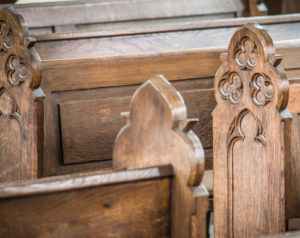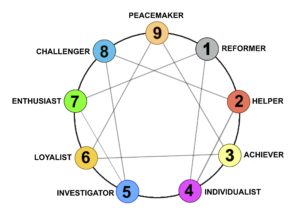“… we all come into this world with a need for connection and protection and with a need for freedom. And from the first moment on, we will be straddling these two needs: what is me, and what is us? … this constant dance between me and you, between I and thou, is at the core of being human.”
-Psychotherapist Esther Perel, from her conversation with Krista Tippett, On Being, 7/8/21
Walking out of the Buddhist meditation center on a cool spring Sunday evening and heading to the car for my drive home, I was certain that I needed something more than sitting in silent meditation with strangers. Having studied and practiced Buddhism for over twenty years in relative isolation except for a few retreats, I knew there were robust Buddhist communities, but not in rural Virginia where I had lived most of my adult life. I longed for a spiritual community that would provide mutual support in the quest for non-attachment – the Buddhist version of freedom.
A week later on Easter morning, having driven to my hometown two hours away and picked up my aging parents, I was sitting between them in the same church pew where I had sat for the first sixteen years of my life as an Episcopalian. The stained glass, the altar, the choir and organ, even the sound of footsteps on the floor washed over me, eliciting positive emotions. When the rector preached a sermon about social justice and the church’s active role in downtown ministries, I looked around and realized this was not the same church I had left in 1969 to attend a Unitarian church as soon as I got my driver’s license.
After that Easter experience, I joined an Episcopal church community and for fifteen years I devoted my spiritual life to becoming faithful in worship, service, fellowship, learning and stewardship. Freedom was not on my radar; I sought the connection and security of a community. And yet despite transformative experiences through worship, close relationships with individuals, and greater intimacy with Christ, I felt that I was living within constrictive boundaries. That Trinitarian goal of Christian freedom — boundless love, joy, and peace, seemed distant, not within my grasp. So now I had community but not freedom.
I have found the way out of my quandary through Fr. Richard Rohr’s ‘Perennial Wisdom’, which emphasizes a freedom found in Christ’s love that operates within faith borders that are permeable. Rohr promotes the use of the Enneagram as an effective personal tool for helping to remove those blinders which prevent us from seeing and experiencing the fullness of God’s good Creation.
The basic premise of the Enneagram is that as children we develop personalities that enable us to navigate a complex and often challenging world. Personalities are a mysterious mix of nature and nurture, and each of us falls into one of nine clearly defined types, which are further refined by the strongest of our three instincts: self-preservation, social and sexual. The Enneagram has an ancient history, but its current form was developed in the 20th century and employs modern psychological understandings.
Rohr explains that our personalities typically enable us to manage a job and develop relationships in the first half of life; however, it’s usually in the second half that our personalities become serious impediments to further growth. We over-identify with our personality, which blinds us to the reality that other personality types experience the world very differently; additionally, our personality tends to smother the divine essence within each of us.
Trusting Fr. Richard’s recommendation, I read two books, took a test, listened to a few podcasts, talked to a couple of friends, and as Enneagram teachers promise, I gradually came to realize my type — a “One.” There is no hierarchy in the nine numbers, though there are specific relationships among them all. Some teachers like to use names as labels to help students identify their type. One school uses these nine names: Reformer, Helper, Achiever, Individualist, Investigator, Loyalist, Enthusiast, Challenger and Peacemaker. One of the Enneagram’s greatest strengths is its ability to help me imagine a world where all nine personality types are needed to create wholeness and beauty in community.
The Enneagram is both science and art. With insights about my type, I can see my personality at work in all my relationships — whether with family, friends, or co-workers. Through this lens much of my past makes more sense, and the Enneagram has helped me see and accept that many of my blunders were the result of living as though I was my personality.
Using the Enneagram in the present moment is where it becomes art. With a growing awareness of how my personality typically operates, I can choose to create a different reality by not reacting in predictable patterns. When I can hold onto this awareness that allows choice and leaves room for Christ, if only for a brief sacred pause, I can experience a type of freedom that Esther Perel describes in her conversation with Krista Tippett as “an active engagement with the unknown…[when] there is a sense of…aliveness…and joy.”
With this transformational tool – the Enneagram – in my pocket, I am back “on the road” seeking a faith community that wants to live in that healthy tension between a life of freedom with God and neighbor, and the connection and protection that comes from belonging. I remain grateful that God provides so many individuals and resources along the Way, and now that includes virtual!
Some helpful Enneagram books and podcasts:
Don Riso & Russ Hudson – The Wisdom of the Enneagram (Bantom Books; 1999)
Ian Cron (& Suzanne Stabile) – The Road Back to You: An Enneagram Journey to Self-Discovery (IVP Books; 2016) and the podcast Typology
Suzanne Stabile – The Path Between Us: An Enneagram Journey to Healthy Relationships (IVP Formatio Books, 2018) and the podcast The Enneagram Journey
Bea Chestnut – The Complete Enneagram (She Writes Press, 2013) and the podcast (with Uranio Paes) Enneagram 2.0
Richard Rohr (and Andreas Ebert) – The Enneagram: A Christian Perspective (Crossroad Publishing, 2001)









